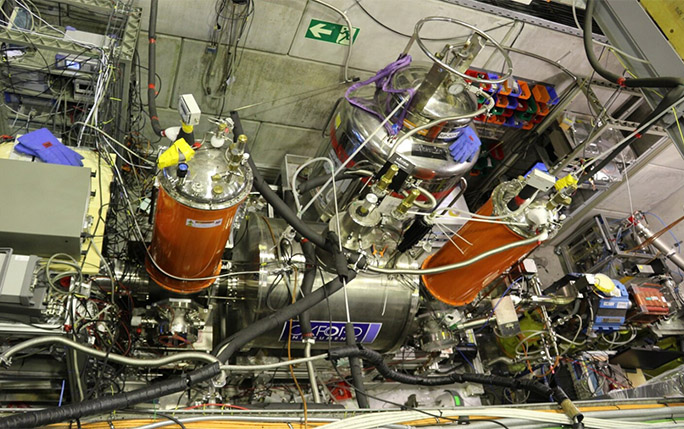BASE opens up new possibilities in the search for cold dark matter

AVA Supervisor Stefan Ulmer and AVA Fellow Markus Wiesinger, as part of the BASE collaboration, have co-authored a paper published in Physical Review Letters. This team of physicists has set new limits on the existence of axion-like particles and they, using a pioneering method, report on how easily those could turn into photons (the particles of light) and describe how this opens up new experimental possibilities in the search for cold dark matter.
Markus Wiesinger’s project within the AVA Network focuses on advanced cooling techniques for protons and antiprotons captured in a Penning Trap with the aim of improved measurements of the proton and antiproton magnetic moment. This Penning Trap is a device that combines electric and strong magnetic fields. To avoid collisions with ordinary matter, the trap is operated at 5 kelvins (around -268 degrees Celsius), a temperature at which exceedingly low pressures, similar to those in deep space, are reached. By carefully adjusting the electric fields, individual antiprotons can be isolated and moved to a separate part of the experiment. In this region, very sensitive superconducting resonant detectors can pick up the tiny electrical currents generated by single antiprotons as they move around the trap.
In the work published, the BASE team looked for unexpected electrical signals in their sensitive antiproton detectors. These detectors are superconducting, have almost no electrical resistance, and are extremely sensitive to small electric fields. The detectors are located in the Penning trap's strong magnetic field; axions from the dark-matter background would interact with this magnetic field and turn into photons, which can then be detected. The antiproton was used as a quantum sensor to calibrate the background noise on the detector. Next, the search began for narrow frequency signatures inconsistent with detector noise, however faint, which could hint at those induced by axion-like particles and their possible interactions with photons. Nothing was found at the frequencies that were recorded, which means that BASE succeeded in setting new upper limits for the possible interactions between photons and axion-like particles with certain masses.
With this study, BASE opens up possibilities for other Penning trap experiments to participate in the search for dark matter. Since BASE was not built to look for these signals, several changes could be made to increase the sensitivity and bandwidth of the experiment and improve the probability of finding an axion-like particle in the future. This new technique has combined two previously unrelated branches of experimental physics: axion physics and high-precision Penning trap physics. The team’s laboratory experiment is complementary to astrophysics experiments and especially sensitive in the low axion-mass range. With a purpose-built instrument there is the opportunity to broaden the landscape of axion searches using Penning trap techniques.
Further information can be found here, with the full publication available via the details below:
J.A. Devlin, et al., “Constraints on the Coupling between Axionlike Dark Matter and Photons Using an Antiproton Superconducting Tuned Detection Circuit in a Cryogenic Penning Trap”, Phys. Rev. Lett. 126, 041301
https://doi.org/10.1103/PhysRevLett.126.041301